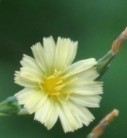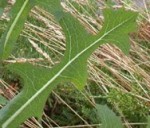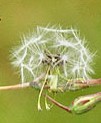 An annual or biennial, prickly lettuce is a native of Eurasia but found throughout the United States. It prefers a sunny site with mesic to dry soil, and is especially common in highly disturbed sites. It can be found in cropland, orchards, gardens, roadsides, abandon fields, fence rows, vacant lots, and dumps.
An annual or biennial, prickly lettuce is a native of Eurasia but found throughout the United States. It prefers a sunny site with mesic to dry soil, and is especially common in highly disturbed sites. It can be found in cropland, orchards, gardens, roadsides, abandon fields, fence rows, vacant lots, and dumps.
 Description:Young plants consist of a rosette of pinately lobed leaves with pointed tips growing up to 14” long and 4” wide. As the plant matures it sends up a single erect, hollow stem, 3-5” tall and green to white in color.
Description:Young plants consist of a rosette of pinately lobed leaves with pointed tips growing up to 14” long and 4” wide. As the plant matures it sends up a single erect, hollow stem, 3-5” tall and green to white in color.
 Leaves are arranged alternately along the stem without petioles and become smaller as they ascend. They have prickles along their margins and along the lower surface of the midvein but these prickles are soft and can not tear clothing or skin. The leaves are said to point north and south giving the plant another
Leaves are arranged alternately along the stem without petioles and become smaller as they ascend. They have prickles along their margins and along the lower surface of the midvein but these prickles are soft and can not tear clothing or skin. The leaves are said to point north and south giving the plant another  common name, compass plant. When cut, both leaves and stem emit a milky sap that is
common name, compass plant. When cut, both leaves and stem emit a milky sap that is foul smelling and used in herbal medicine. Flowering stems appear in the upper portions of the main stem and produce hundreds of yellow flower heads 1/3” across and made up of five to twenty ray florets. Each floret produces a fruit with a single seed that is tufted to facilitate wind dispersal and can remain in the soil for up to three years if winters are mild. A long thick taproot anchors the plant.
foul smelling and used in herbal medicine. Flowering stems appear in the upper portions of the main stem and produce hundreds of yellow flower heads 1/3” across and made up of five to twenty ray florets. Each floret produces a fruit with a single seed that is tufted to facilitate wind dispersal and can remain in the soil for up to three years if winters are mild. A long thick taproot anchors the plant.

 Control: Hand pulling young plants before the taproot develops is the best method of control. Once the plant has established the taproot stems can be removed with a below the soil line to prevent roots from sprouting. Common herbicides such as dicamba, 2,4-D, and glyphosate can be employed for heavy infestations.
Control: Hand pulling young plants before the taproot develops is the best method of control. Once the plant has established the taproot stems can be removed with a below the soil line to prevent roots from sprouting. Common herbicides such as dicamba, 2,4-D, and glyphosate can be employed for heavy infestations.